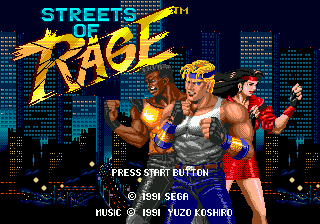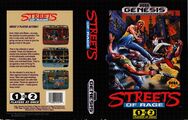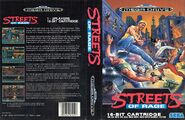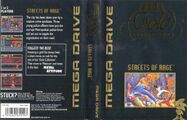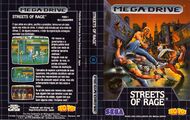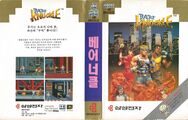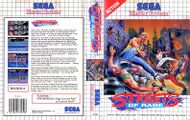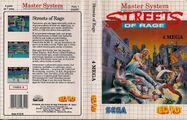Difference between revisions of "Streets of Rage"
From Sega Retro
| Line 54: | Line 54: | ||
==Development== | ==Development== | ||
| − | ''Streets of Rage'' was | + | ''Streets of Rage'' was developed by Sega as an answer to [[Capcom]]'s highly rated arcade beat-'em-up, ''Final Fight'' (or more specifically, the Super Famicom version from December 1990, which despite cutbacks, was proving a hit in Japan). The fledgling Sega Mega Drive had several beat-'em-ups in its game library at the time (most notably the likes of ''[[Golden Axe]]'' and ''[[Alien Storm]]''), but most were ports of old arcade games and weren't generating as much interest in the system as Sega would have liked. With Capcom choosing to favour Nintendo's machine over Sega's (for the time being at least), the company decided to create a brand new beat-'em-up game from scratch which would be exclusive to their console(s). |
| − | + | ''Streets of Rage'' was developed internally by [[Sega AM7]], and was set to address features lacking in the SNES adaption of ''Final Fight''. Unlike its rival, ''Streets of Rage'' was able to provide three playable characters and two-player co-operative play, as well as being able to support more characters on screen. | |
| − | == | + | The music for ''Streets of Rage'' was composed by [[Yuzo Koshiro]], who had previously offered his talents for ''[[Revenge of Shinobi]]''. Koshiro was influenced by electronic dance and club music, specifically of the techno and house varieties, and intended to be the first to introduce these sounds to video games. The final soundtrack also shows the influence of contemporary R&B and hip hop music - styles which in the late 1980s and early 1990s, were immensely popular, particularly in the western hemisphere. |
| − | + | ||
| + | Yuzo Koshiro claimed the most important element when recreating club music sounds for video games was to emulate the timbre and percussion sounds of rhythm machines, citing models by Roland Corporation (such as the TR-606, TR-707, TR-808, and TR-909). Music is one of the key elements of ''Streets of Rage'', with Koshiro's soundtrack being widely praised by the press of the era and inspiring his subsequent ''[[Streets of Rage 2]]'' and ''[[Streets of Rage 3]]'' soundtracks. | ||
| + | |||
| + | Like its sequels, ''Streets of Rage'''s soundtrack was composed using a PC-8801 computer, alongside an original audio programming language developed by Yuzo Koshiro himself. "MML", or "Music Macro Language" is based on NEC's variant of the BASIC language, but is modified to involve elements from assembly code. | ||
| + | |||
| + | Master System and Game Gear versions of ''Streets of Rage'' were produced following the success of the Mega Drive original (curiously this game stands as one of the few occasions where the Master System port is entirely different to the Game Gear one, with different game assets). The Game Gear version lacks stage 6, has only two characters and sports simpler graphics, while the Master System version omits two player co-operative support. | ||
| + | |||
| + | ==Story== | ||
| + | ''Streets of Rage'' takes place in a New York-inspired city that which has been taken over by an evil syndicate, headed by the evil Mr. X. Chaos ensues and out of it comes three brave ex-cops: Axel Stone, Blaze Fielding, and Adam Hunter. Together they are willing to risk everything including their own lives to free the city from the evil syndicate. | ||
{{quote|This city was once a happy, peaceful place...until one day, a powerful secret criminal organization took over. This vicious syndicate soon had control of the government and even the police force. The city has become a center of violence where no one is safe. | {{quote|This city was once a happy, peaceful place...until one day, a powerful secret criminal organization took over. This vicious syndicate soon had control of the government and even the police force. The city has become a center of violence where no one is safe. | ||
| Line 67: | Line 75: | ||
Streets of Rage|Opening sequence}} | Streets of Rage|Opening sequence}} | ||
| − | == | + | ==Gameplay== |
| + | Gameplay is typical for a beat-'em-up from the era, and shares many similarities to prior Sega game of this nature. {{B}} punches and {{C}} jumps, and in mid-air, {{B}} causes the character to perform a jumping kick. For the most part, movement is two dimensional, however as was the standard for the time, players can walk into and out of the screen, creating a primitive "2.5" style of gameplay. Though it is possible to walk left, the screen will only scroll to the right in most circumstances, making extended backtracking an impossibility. | ||
| + | |||
| + | Like ''Final Fight'', ''Streets of Rage'' has a primitive weapon system. If the player is standing over a weapon {{B}} will pick it up and, with subsequent {{B}} presses attacking with it. Pressing {{B}} and {{C}} together iwill trigger a rear attack, and it is possible for the player to grapple close range enemies without taking damage. | ||
| + | |||
| + | Similar to ''Golden Axe'''s magic spells, ''Streets of Rage'' assigns {{A}} to a special attack, which takes the form of a police car that fires a bazookas at enemies on-screen. In multiplayer games the effect is exacerbated for even greater damage. Subsequent games would eliminate the police car, possibly in the interests of retaining gameplay flow, but also because the command is unusable in certain situations (such as the last round, where players find themselves on the top floor of a skyscraper indoors. | ||
| + | |||
===Playable Characters=== | ===Playable Characters=== | ||
| − | *'''Axel Stone:''' Axel | + | *'''Axel Stone:''' Axel is a 22 year-old white blond male who is skilled at Martial Arts and loves to play video games. The well rounded option, Axel is one of only two characters to appear in all three ''Streets of Rage'' games (the other one being Blaze Fielding). |
| − | *'''Adam Hunter:''' | + | *'''Adam Hunter:''' Adam is a black 23 year old male who excels in boxing and is the powerhouse of the three. The downside however, is that he moves more slowly than the others, affecting his handling. |
| − | *'''Blaze Fielding:''' Blaze is a 21 year old white female | + | *'''Blaze Fielding:''' Blaze is a 21 year old white female, who enjoys lambada as a hobby and is a master at judo martial arts. Blaze is physically weaker than Axel and Adam, however is the fastest, and more appropraite choice for new players. |
===Bosses=== | ===Bosses=== | ||
| Line 77: | Line 91: | ||
*'''Antonio''': Antonio is the boss of Round 1. As his name implies, he wields a large boomerang and can sometimes kick. Antonio also appears in Round 8. | *'''Antonio''': Antonio is the boss of Round 1. As his name implies, he wields a large boomerang and can sometimes kick. Antonio also appears in Round 8. | ||
| − | *'''Souther''': Souther is the boss of Round 2. He has claws attached to his gloves and can lunge at the player from far away. He can also counter the players' flying kicks with a slashing attack that leaves after images (it is possible to hit him with a flying kick but difficult to do and not recommended). In Round 6, two Souther will appear as the boss. He also appears in Round 8. Souther's name is reused as an alternate name for a similar enemy encountered in ''Streets of Rage 2'' named Zamza | + | *'''Souther''': Souther is the boss of Round 2. He has claws attached to his gloves and can lunge at the player from far away. He can also counter the players' flying kicks with a slashing attack that leaves after images (it is possible to hit him with a flying kick but difficult to do and not recommended). In Round 6, two Souther will appear as the boss. He also appears in Round 8. Souther's name is reused as an alternate name for a similar enemy encountered in ''Streets of Rage 2'' named Zamza. |
| − | *'''Abadede''': Abadede is the boss of Round 3. He is a muscular brute who can charge and punch from long distances. He also appears in Round 5, and Round 8 | + | *'''Abadede''': Abadede is the boss of Round 3. He is a muscular brute who can charge and punch from long distances. He also appears in Round 5, and Round 8. |
| − | *'''Bongo''': Bongo is the boss of Round 4. He is a big-bellied fighter who can breath fire and walk quickly across the screen diagonally. A player will take damage if he or she attempts to throw him. He also appears in Round 6, and Round 8 | + | *'''Bongo''': Bongo is the boss of Round 4. He is a big-bellied fighter who can breath fire and walk quickly across the screen diagonally. A player will take damage if he or she attempts to throw him. He also appears in Round 6, and Round 8. |
| − | *'''Onihime and Yasha''': Onihime and Yasha are twins who resemble Blaze. Because they attack together and are always jumping around, they can be difficult to defeat. Their most common attacks are kicking in midair and grappling | + | *'''Onihime and Yasha''': Onihime and Yasha are twins who resemble Blaze. Because they attack together and are always jumping around, they can be difficult to defeat. Their most common attacks are kicking in midair and grappling. |
| − | *'''Mr. X:''' Mr.X is the final boss and head of the syndicate. He is the main antagonist throughout the series. Generally he carries around a machine gun when fighting or sits on his throne sicking goons on the player | + | *'''Mr. X:''' Mr.X is the final boss and head of the syndicate. He is the main antagonist throughout the series. Generally he carries around a machine gun when fighting or sits on his throne sicking goons on the player. |
===Regular Enemies=== | ===Regular Enemies=== | ||
| − | *'''Garcia/Galsia''': This is the first and most common punk encountered throughout the game. Galsia ( | + | *'''Garcia/Galsia''': This is the first and most common punk encountered throughout the game. Galsia (the more accepted name, introduced in ''Streets of Rage 2'') attacks the player frequently and sometimes has either knives or baseball bats to attack the player with. He has two different knife attacks; the notorious "charging" type in which he runs at players, and a more typical throwing type. The latter version will not drop knives even if you throw him and is more commonly encountered on higher difficulties. Galsia has returned in all of the ''Streets of Rage''/''Bare Knuckle'' games, becoming as iconic to many as some of the main characters. |
| − | *'''Nora''': Nora is a female enemy who carries a whip. According to the Japanese manual, she works for questionable members-only clubs where everyone calls her queen. Nora uses her whip to hit and knock down the player | + | *'''Nora''': Nora is a female enemy who carries a whip. According to the Japanese manual, she works for questionable members-only clubs where everyone calls her queen. Nora uses her whip to hit and knock down the player, though if knocked down herself, some Nora enemies may get down on their hands and knees and will be invulnerable until they get up. Throwing Nora prevents her from doing this. |
| − | *'''Y.Signal''': A | + | *'''Y.Signal''': A common enemy easily identifiable by colourful mohawks. Though Y.Signal will occasionally punch the player, he prefers to throw the player or perform sliding kicks to knock them off of their feet, both of which become more common when playing at a higher difficulty setting. |
| − | *'''Haku-Oh''': | + | *'''Haku-Oh''': According to the Japanese manual, Haku-Oh is a student of the 4000 year old Chinese art of Shaolin Kung Fu. The character is a ruthlessness member of the syndicate who uses flying kicks on the player and well as having a habit of jumping from behind scenery in some stages (such as the boat in Round 5). |
| − | *'''Jack''': | + | *'''Jack''': Jack is a Juggler who will juggle dangerous things such as hatchets or torches, throwing things at the player intermittently. An alternative type will only attack if the player stands still long enough. Walking into an armed Jack who will knock the player down. According to the Japanese manual, Jack works part time as a circus clown and despite being funny for a living, is quite strong. In prototype screenshots, his outfit is very different and he seems dressed similar to Galsia. |
| + | Memory restrtictions mean that despite the existence of biographies, enemy characters are frequently recycled. This means that throughout the journey, the player will encounter, for example, multiple Garcias with identical clothing and stats. | ||
| − | == | + | ==Soundtrack== |
| − | + | :Main article: ''[[Bare Knuckle (album)]]'' | |
| − | |||
| − | |||
| − | == | + | ==Sequels and Re-releases== |
| − | + | ''Streets of Rage'''s success led to the release of two major sequels, ''[[Streets of Rage 2]]'' and ''[[Streets of Rage 3]]''. Attempts at a "Streets of Rage 4" have been made, but none have yet surfaced as commercial products. | |
| − | + | The game has been included in a multitude of compilations spanning two decades, and was also bundled with Mega Drive systems in North America and Europe. Of all these, the [[Sega Mega CD]] version included in ''[[Sega Classics Arcade Collection]]'' is perhaps the most notable due to its inclusion of higher quality sound effects. ''Streets of Rage'' was also released for [[Mega-Tech]] and [[Mega Play]] arcade hardware and is available through several download services, including the [[Wii]]'s [[Virtual Console]], iOS and Steam. | |
==Production Credits== | ==Production Credits== | ||
Revision as of 14:47, 23 April 2013
| Streets of Rage | |||||
|---|---|---|---|---|---|
| System(s): Sega Mega Drive, Sega Game Gear, Sega Master System, Virtual Console, iOS, Steam | |||||
| Publisher: Sega | |||||
| Developer: Sega AM7, Ancient | |||||
| Peripherals supported: Gear-to-Gear Cable | |||||
| Genre: Action | |||||
| |||||
|
CERO
Missing Parameter! |
Streets of Rage, known as Bare Knuckle: Ikari no Tetsuken (ベア・ナックル 怒りの鉄拳) in Japan, is a beat 'em up video game released by Sega for the Sega Mega Drive in 1991, before subsequently arriving on the Sega Game Gear and Sega Master System. It was the first in Sega's then-flagship Streets of Rage series.
Contents
Development
Streets of Rage was developed by Sega as an answer to Capcom's highly rated arcade beat-'em-up, Final Fight (or more specifically, the Super Famicom version from December 1990, which despite cutbacks, was proving a hit in Japan). The fledgling Sega Mega Drive had several beat-'em-ups in its game library at the time (most notably the likes of Golden Axe and Alien Storm), but most were ports of old arcade games and weren't generating as much interest in the system as Sega would have liked. With Capcom choosing to favour Nintendo's machine over Sega's (for the time being at least), the company decided to create a brand new beat-'em-up game from scratch which would be exclusive to their console(s).
Streets of Rage was developed internally by Sega AM7, and was set to address features lacking in the SNES adaption of Final Fight. Unlike its rival, Streets of Rage was able to provide three playable characters and two-player co-operative play, as well as being able to support more characters on screen.
The music for Streets of Rage was composed by Yuzo Koshiro, who had previously offered his talents for Revenge of Shinobi. Koshiro was influenced by electronic dance and club music, specifically of the techno and house varieties, and intended to be the first to introduce these sounds to video games. The final soundtrack also shows the influence of contemporary R&B and hip hop music - styles which in the late 1980s and early 1990s, were immensely popular, particularly in the western hemisphere.
Yuzo Koshiro claimed the most important element when recreating club music sounds for video games was to emulate the timbre and percussion sounds of rhythm machines, citing models by Roland Corporation (such as the TR-606, TR-707, TR-808, and TR-909). Music is one of the key elements of Streets of Rage, with Koshiro's soundtrack being widely praised by the press of the era and inspiring his subsequent Streets of Rage 2 and Streets of Rage 3 soundtracks.
Like its sequels, Streets of Rage's soundtrack was composed using a PC-8801 computer, alongside an original audio programming language developed by Yuzo Koshiro himself. "MML", or "Music Macro Language" is based on NEC's variant of the BASIC language, but is modified to involve elements from assembly code.
Master System and Game Gear versions of Streets of Rage were produced following the success of the Mega Drive original (curiously this game stands as one of the few occasions where the Master System port is entirely different to the Game Gear one, with different game assets). The Game Gear version lacks stage 6, has only two characters and sports simpler graphics, while the Master System version omits two player co-operative support.
Story
Streets of Rage takes place in a New York-inspired city that which has been taken over by an evil syndicate, headed by the evil Mr. X. Chaos ensues and out of it comes three brave ex-cops: Axel Stone, Blaze Fielding, and Adam Hunter. Together they are willing to risk everything including their own lives to free the city from the evil syndicate.
| “ | This city was once a happy, peaceful place...until one day, a powerful secret criminal organization took over. This vicious syndicate soon had control of the government and even the police force. The city has become a center of violence where no one is safe.
Amid this turmoil, group of young Police officers has sworn to clean up the city. Among them are Adam Hunter, Axel Stone, and Blaze Fielding. They are willing to risk anything...even their lives...on the... Streets of Rage |
„ |
— Opening sequence | ||
Gameplay
Gameplay is typical for a beat-'em-up from the era, and shares many similarities to prior Sega game of this nature. ![]() punches and
punches and ![]() jumps, and in mid-air,
jumps, and in mid-air, ![]() causes the character to perform a jumping kick. For the most part, movement is two dimensional, however as was the standard for the time, players can walk into and out of the screen, creating a primitive "2.5" style of gameplay. Though it is possible to walk left, the screen will only scroll to the right in most circumstances, making extended backtracking an impossibility.
causes the character to perform a jumping kick. For the most part, movement is two dimensional, however as was the standard for the time, players can walk into and out of the screen, creating a primitive "2.5" style of gameplay. Though it is possible to walk left, the screen will only scroll to the right in most circumstances, making extended backtracking an impossibility.
Like Final Fight, Streets of Rage has a primitive weapon system. If the player is standing over a weapon ![]() will pick it up and, with subsequent
will pick it up and, with subsequent ![]() presses attacking with it. Pressing
presses attacking with it. Pressing ![]() and
and ![]() together iwill trigger a rear attack, and it is possible for the player to grapple close range enemies without taking damage.
together iwill trigger a rear attack, and it is possible for the player to grapple close range enemies without taking damage.
Similar to Golden Axe's magic spells, Streets of Rage assigns ![]() to a special attack, which takes the form of a police car that fires a bazookas at enemies on-screen. In multiplayer games the effect is exacerbated for even greater damage. Subsequent games would eliminate the police car, possibly in the interests of retaining gameplay flow, but also because the command is unusable in certain situations (such as the last round, where players find themselves on the top floor of a skyscraper indoors.
to a special attack, which takes the form of a police car that fires a bazookas at enemies on-screen. In multiplayer games the effect is exacerbated for even greater damage. Subsequent games would eliminate the police car, possibly in the interests of retaining gameplay flow, but also because the command is unusable in certain situations (such as the last round, where players find themselves on the top floor of a skyscraper indoors.
Playable Characters
- Axel Stone: Axel is a 22 year-old white blond male who is skilled at Martial Arts and loves to play video games. The well rounded option, Axel is one of only two characters to appear in all three Streets of Rage games (the other one being Blaze Fielding).
- Adam Hunter: Adam is a black 23 year old male who excels in boxing and is the powerhouse of the three. The downside however, is that he moves more slowly than the others, affecting his handling.
- Blaze Fielding: Blaze is a 21 year old white female, who enjoys lambada as a hobby and is a master at judo martial arts. Blaze is physically weaker than Axel and Adam, however is the fastest, and more appropraite choice for new players.
Bosses
The following names come from the Japanese manual:
- Antonio: Antonio is the boss of Round 1. As his name implies, he wields a large boomerang and can sometimes kick. Antonio also appears in Round 8.
- Souther: Souther is the boss of Round 2. He has claws attached to his gloves and can lunge at the player from far away. He can also counter the players' flying kicks with a slashing attack that leaves after images (it is possible to hit him with a flying kick but difficult to do and not recommended). In Round 6, two Souther will appear as the boss. He also appears in Round 8. Souther's name is reused as an alternate name for a similar enemy encountered in Streets of Rage 2 named Zamza.
- Abadede: Abadede is the boss of Round 3. He is a muscular brute who can charge and punch from long distances. He also appears in Round 5, and Round 8.
- Bongo: Bongo is the boss of Round 4. He is a big-bellied fighter who can breath fire and walk quickly across the screen diagonally. A player will take damage if he or she attempts to throw him. He also appears in Round 6, and Round 8.
- Onihime and Yasha: Onihime and Yasha are twins who resemble Blaze. Because they attack together and are always jumping around, they can be difficult to defeat. Their most common attacks are kicking in midair and grappling.
- Mr. X: Mr.X is the final boss and head of the syndicate. He is the main antagonist throughout the series. Generally he carries around a machine gun when fighting or sits on his throne sicking goons on the player.
Regular Enemies
- Garcia/Galsia: This is the first and most common punk encountered throughout the game. Galsia (the more accepted name, introduced in Streets of Rage 2) attacks the player frequently and sometimes has either knives or baseball bats to attack the player with. He has two different knife attacks; the notorious "charging" type in which he runs at players, and a more typical throwing type. The latter version will not drop knives even if you throw him and is more commonly encountered on higher difficulties. Galsia has returned in all of the Streets of Rage/Bare Knuckle games, becoming as iconic to many as some of the main characters.
- Nora: Nora is a female enemy who carries a whip. According to the Japanese manual, she works for questionable members-only clubs where everyone calls her queen. Nora uses her whip to hit and knock down the player, though if knocked down herself, some Nora enemies may get down on their hands and knees and will be invulnerable until they get up. Throwing Nora prevents her from doing this.
- Y.Signal: A common enemy easily identifiable by colourful mohawks. Though Y.Signal will occasionally punch the player, he prefers to throw the player or perform sliding kicks to knock them off of their feet, both of which become more common when playing at a higher difficulty setting.
- Haku-Oh: According to the Japanese manual, Haku-Oh is a student of the 4000 year old Chinese art of Shaolin Kung Fu. The character is a ruthlessness member of the syndicate who uses flying kicks on the player and well as having a habit of jumping from behind scenery in some stages (such as the boat in Round 5).
- Jack: Jack is a Juggler who will juggle dangerous things such as hatchets or torches, throwing things at the player intermittently. An alternative type will only attack if the player stands still long enough. Walking into an armed Jack who will knock the player down. According to the Japanese manual, Jack works part time as a circus clown and despite being funny for a living, is quite strong. In prototype screenshots, his outfit is very different and he seems dressed similar to Galsia.
Memory restrtictions mean that despite the existence of biographies, enemy characters are frequently recycled. This means that throughout the journey, the player will encounter, for example, multiple Garcias with identical clothing and stats.
Soundtrack
- Main article: Bare Knuckle (album)
Sequels and Re-releases
Streets of Rage's success led to the release of two major sequels, Streets of Rage 2 and Streets of Rage 3. Attempts at a "Streets of Rage 4" have been made, but none have yet surfaced as commercial products.
The game has been included in a multitude of compilations spanning two decades, and was also bundled with Mega Drive systems in North America and Europe. Of all these, the Sega Mega CD version included in Sega Classics Arcade Collection is perhaps the most notable due to its inclusion of higher quality sound effects. Streets of Rage was also released for Mega-Tech and Mega Play arcade hardware and is available through several download services, including the Wii's Virtual Console, iOS and Steam.
Production Credits
Mega Drive Version
Game Designed by: There Is "No" Accounting for Tastes., Tinon
Programmed by: Momonga Momo, Little Sun
Designed by: Seishi Atsumiya, Nandemo, Rascal Fuku-Chan, Udi
Music by: Yuzo Koshiro
Sound Assisted: T.N
Special Thanks to: Bo, Ore, Kottu, Thunder, Yamaichi, Scott
Presented by: Sega 1991
Game Gear Version
Game Designed by: Abadede
Programmed by: Nag, AT1000, IK
Designed by: Abadede, Honey
Music by: Yuzo Koshiro, Mikito Ichikawa
Special Thanks to: Mul, Kei
Presented by: Sega 1992
Physical Scans
Mega Drive Version
| 84 | |
|---|---|
| Based on 46 reviews | |
| Mega Drive, US (Sega Classic) |
|---|
| Mega Drive, AU (Sega Gold Collection) |
|---|
Master System Version
| Sega Retro Average | ||||||||||||||||||||||||||||||||||||||||||||||||||||||||||||||||||||||||||
|---|---|---|---|---|---|---|---|---|---|---|---|---|---|---|---|---|---|---|---|---|---|---|---|---|---|---|---|---|---|---|---|---|---|---|---|---|---|---|---|---|---|---|---|---|---|---|---|---|---|---|---|---|---|---|---|---|---|---|---|---|---|---|---|---|---|---|---|---|---|---|---|---|---|---|
|
| 76 | |
|---|---|
| Based on 14 reviews | |
Game Gear Version
| Sega Retro Average | |||||||||||||||||||||||||||||||||||||||||||||||||||||||||||||||||||||||||||||||||||||||||||||||||||||||||||||||||||||||||||||||||
|---|---|---|---|---|---|---|---|---|---|---|---|---|---|---|---|---|---|---|---|---|---|---|---|---|---|---|---|---|---|---|---|---|---|---|---|---|---|---|---|---|---|---|---|---|---|---|---|---|---|---|---|---|---|---|---|---|---|---|---|---|---|---|---|---|---|---|---|---|---|---|---|---|---|---|---|---|---|---|---|---|---|---|---|---|---|---|---|---|---|---|---|---|---|---|---|---|---|---|---|---|---|---|---|---|---|---|---|---|---|---|---|---|---|---|---|---|---|---|---|---|---|---|---|---|---|---|---|---|---|
|
| 77 | |
|---|---|
| Based on 25 reviews | |
| Game Gear, US |
|---|
<div style="margin:auto; max-width:Expression error: Unexpected < operator.px">
 Cover
|
| Game Gear, EU (Classic) |
|---|
|
| Game Gear, BR |
|---|
|
External Links
- Sega of Japan Virtual Console page (Japanese)
- Streets of Rage on Apple.com: GB, US
- Streets of Rage on Steam
- Streets of Rage on Streets of Rage Online
- Gear-to-Gear Cable-compatible games
- No players field
- Old content rating field
- Use romtable template
- All games
- Quote with no reference
- Old-style rating (ace)
- Old-style rating (asm)
- Rating without source
- Old-style rating (consolesplus)
- Rating without PDF source
- Old-style rating (cvg)
- Old-style rating (egm)
- Old-style rating (gamesx)
- Old-style rating (hobbyconsolas)
- Old-style rating (joypad)
- Old-style rating (joystick)
- Old-style rating (megatech)
- Old-style rating (mm)
- Old-style rating (playerone)
- Old-style rating (pp)
- Old-style rating (segapower)
- Old-style rating (segapro)
- Update ratings template
- 16 old ratings
- Old-style rating (megaforce)
- Old-style rating (megafun)
- Old-style rating (micromania)
- Old-style rating (mms)
- 7 old ratings
- 4 old ratings
- Pages with broken file links
- Mega-Tech games
- Mega Play games
